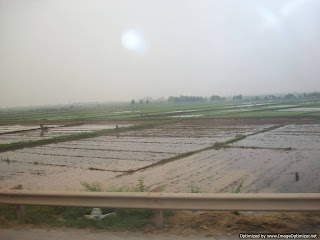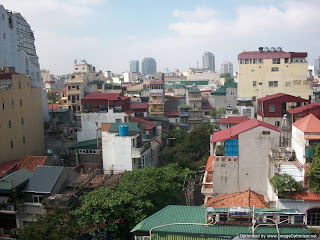GOOD MORNING VIETNAM!!! This was the theme that seemed to stick with us from our weekend trip to Ho Chi Minh City (HCMC). This could be because we watched Robin Williams's movie Saturday night, but it could also be from the excessively early flight we were cattle prodded onto forcing us back to Hanoi at 6:30 am Tuesday morning.
HCMC seemed much more welcoming and homey to us than our temporary home in Hanoi. Formerly known as Saigon, the city was renamed to honor “Uncle Ho” following the fall of Saigon to the Socialist Republic of Vietnam. The reason we visited HCMC over the weekend was to visit one of our own, Erik Page, class of 1990. Erik is the US Vice Consul to Vietnam at the US Consulate in HCMC. After reading about our trip to Vietnam through the school's Web site, he contacted us and invited us to come down and visit him. Erik is the head of the Fraud Prevention Unit and largely the “gate keeper” for immigration to the States from Vietnam. As one might imagine, this is no small task.
We arrived in HCMC on Saturday afternoon, and we found a small guest house down a tight alley that cost VND 400,000 per night, which is the equivalent of USD 20. It was the nicest place we have found to stay during our travels throughout Vietnam. It came with a refrigerator, two clean beds, our own bathroom, and an amazing air conditioning system. We settled into the room and utilized it for some much needed R&R.
On Sunday morning we met Erik for breakfast at a restaurant called The Elbow Room. Upon arrival, he greeted us with a warm Southern smile and a firm handshake. The ring was a sight for sore eyes after being here for three weeks and not seeing anyone from our neck of the woods. We sat down to order, and he recommended a drink called “ca phe sua da,” which is iced coffee with milk. He warned us about it, saying he limits himself to three ca phe sua da per week, because it has the caffeine equivalent of three cokes. During breakfast we soaked up Erik's knowledge about Vietnam and the nature of US-Vietnamese foreign relations. After having two ca phe sua da and a massive breakfast burrito, we were all ready to check out HCMC.
First, Erik took us to Nhà thờ Đức Bà, which is the Notre-Dame Cathedral. It sat in the middle of a five road intersection, and was guarded by a tall statue of the Blessed Mother Mary. It was immediately apparent that this is a popular site for wedding pictures, as the church was surrounded by beautiful Vietnamese women in their ornate white dresses. Erik explained a little about the history of Catholicism in Vietnam and the troubled past that Vietnamese Catholics have faced over many years.
Our next stop with Erik was the old Saigon post office. We stopped in and viewed the beautiful architecture of the building, which was designed by Gustave Eiffel and constructed when Vietnam was part of French Indochina in the early 20th century. While touring the interior, we sent some post cards back home to friends and family, letting them know where we were and how we were doing. It was a fun way to say hello after being gone for several weeks.
Afterward, we parted ways with Erik and went on to a local market. This proved to be a stressful experience as we squeezed through the many aisles of Vietnamese clothes, leathers, watches, jewelry, and food. Shopping in a Vietnamese market is very different from our large shopping centers back home, because you are being constantly grabbed at and harassed by the chaotic marketing strategies of the local Vietnamese vendors. Every purchase is a bartering battle and every step through the market is a strategic move around some obstacle, whether it be a vendor or a pile of merchandise. After regrouping and taking a lunch break, we headed to Dinh Thống Nhất, Reunification Palace.
The Reunification Palace, with its 1970s style layout was the home of South Vietnam's President, Ngô Đình Diệm, and the center of government, during the Vietnam War. It was also the site where North Vietnam rolled two Russian tanks over the gates guarding the palace signaling the end of the war in 1975. The building contained everything a palace might be expected to have, including a huge stair case, excessively long conference tables, fancy banquet halls, elaborately furnished entertainment rooms, a full theater, a long road between a park leading up to its gates, wood inlaid murals on the walls, a large water fountain, and a lot of signs saying “No Touch.” It gave me an eerie feeling considering its historical significance and the many images it conjured from its past exposure to conflict.
Our next stop was the War Remnants Museum, formerly called the American War Crimes Museum. It offered an obviously biased and largely inaccurate view of the Vietnam War. Every description of the pictures on the wall painted US soldiers in a negative light, and the museum completely ignored the nature of this civil war, in which the Vietnamese were killing each other. It was a very rattling experience to see the war from this perspective.
That evening, we met Erik at a colonial French restaurant and chowed down on many different foods. His jovial character lightened the mood after a long afternoon of seeing the city, in particular the War Remnants Museum. I had salted squid for the first time, which was a light yellow color and rubbery, but it tasted really good with sweetened fish sauce and lemon salt dip. Following dinner, Erik took us to an amazing ice cream parlor call Fanny's. It had a huge selection of different ice creams and was a great way to wrap up the day.
Monday morning we met Erik at the US Consulate. He gave us a tour of the grounds and told us about its history as well as his role there. After our tour he led us to a conference room where he had arranged an information session with members of the US Secret Service, US Diplomatic Security, and a foreign services officer in the politics cone. They each gave us overviews of their jobs and told us about how they got started. They gave us great advice on what to do if interested in pursuing careers in their job fields. It was such a great chance to meet with individuals in well-established career paths, as I am in the process of choosing a career personally. They were very welcoming to us and more than willing to help us out in the future should we have any questions.
After the meeting, we said our good-byes to Erik. We had not expected to get such an informative session and thanks to Erik we were able to have a great experience in HCMC. After only a few hours of sleep Monday night, we climbed out of bed before 5:00 am and headed to the airport to fly back to the Volunteer Peace House to continue our work. Our trip to HCMC was a great success!
-Keegan Bailey
Oscar '12




